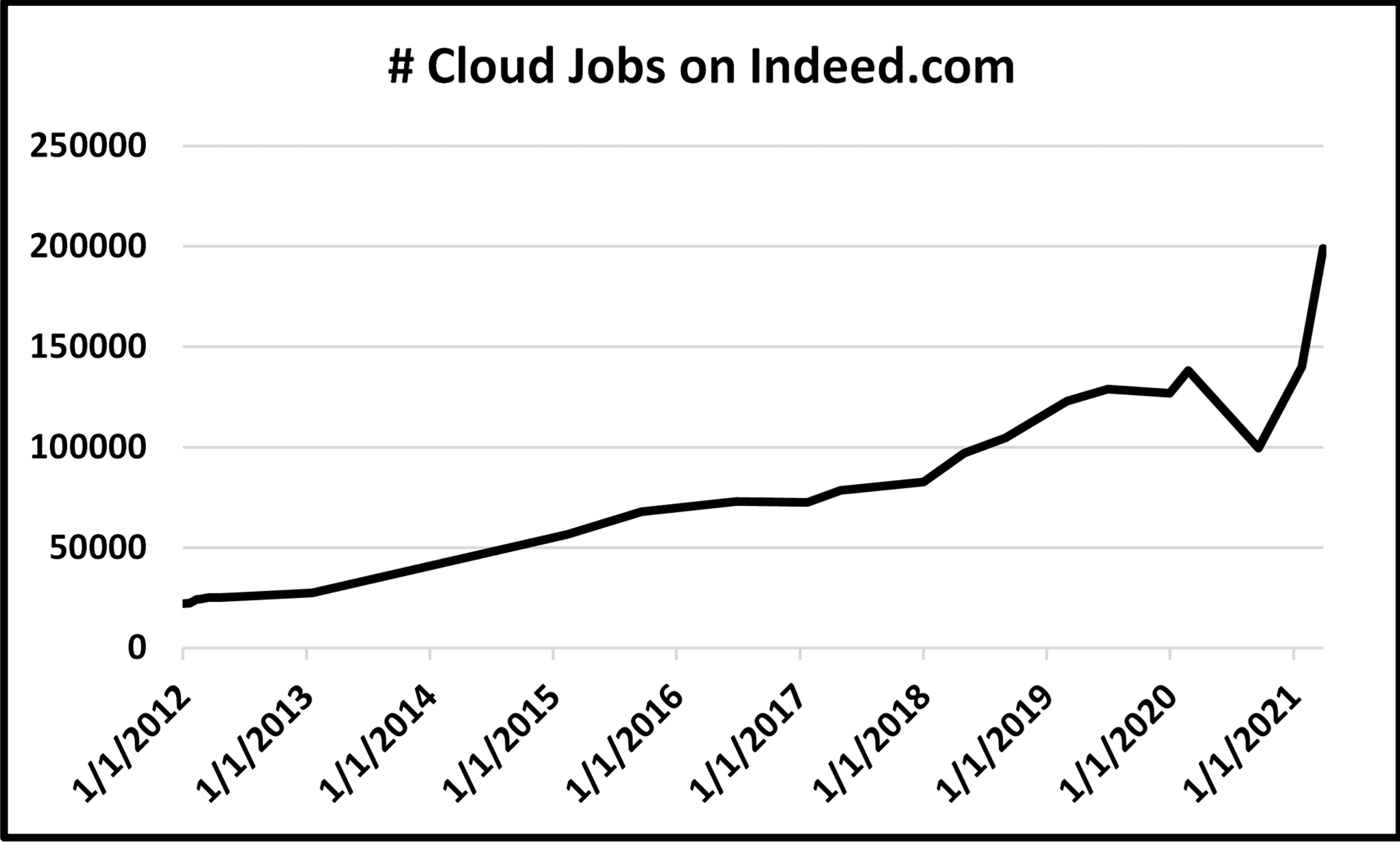
Cloud Computing: The New Plastics
Frederick Scholl April 01, 2021

Frederick Scholl April 01, 2021

In the iconic 1967 movie The Graduate, Mr. McGuire tells Ben that he should go into “plastics”. If the movie were to be rewritten for today, I can see him saying “cloud”. Cloud computing continues its advance into all things IT, and I don’t see any boundaries limiting its growth.
My excel graph shows jobs listed on Indeed that have cloud in the description. So, it includes business jobs and IT jobs. Also, jobs in St. Cloud, MN! It is not scientific but does show some trends. When I started in 2012, security was the biggest concern. However, gradually, adoption increased. When I saw the leveling off around 2016, I thought cloud could be a niche technology. However, adoption increased even more rapidly up to the pandemic. I wasn’t sure when or if cloud jobs would come back, post pandemic. However, it’s obvious from the graph they have. More recently, I think we are seeing the explosion resulting from many companies saying workers will not have to return full time to a “work” office. That’s promoting more and more cloud applications. In my mind security is still a big concern as “the cloud” presents a bigger and bigger attack surface. For a more scientific analysis of technology trends, I turn to the Society for Information Management.

Every year the Society for Information Management (SIM) does a survey of IT professionals (“IT Trends Study”). 624 organizations were surveyed this year; 97% are in the US; 32% are publicly traded companies. The survey attempts to determine trends and areas of concern among IT Directors and CIOs. I believe it is the most insightful and unbiased such survey. To get it you need to be a member of SIM (www.simnet.org), which I have been for many years. Here I am going to summarize some of the 2020 survey results, focusing on cloud and security. My day job is directing Quinnipiac’s MS in Cybersecurity; get more information on that program.
The SIM survey reports on the top ten IT investments for the reporting organizations; the table below show the top 5 investments for 2020 and 2019.
| Technology | 2020 | 2019 |
| Cloud Computing (IaaS, PaaS, SaaS) | 1 | 2 |
| Analytics/Business Intelligence/Forecasting/Big Data | 2 | 1 |
| Security/Cybersecurity | 3 | 3 |
| Software Development/Maintenance | 4 | 4 |
| CRM (Customer Relationship Management) | 5 |
5 |
After 10 years as #1, Analytics/Business Intelligence got bumped to #2! ERP used to be a top 5 investment, but now is relegated to the bottom of this list. Probably many users are employing SaaS ERP solutions, vs. on prem. The report also notes a big jump from #16 to #8 for Collaboration tools, all of which will be running in cloud environments.
The SIM Survey also asked for more details on cloud architecture. The table here shows the percent of organizations using public, multi-tenant cloud, vs. internal private clouds vs. external, single tenant dedicated clouds. The trend line favors public multitenant cloud usage.
| Cloud Technology | Percent Organizations Using |
| Internal private | 13% |
| Public multitenant | 51% |
| External, single tenant dedicated | 18% |
The Survey also contained numerous statistics and trends related to cybersecurity. First up are the Top Five IT management issues:
| IT Management Issue | Importance to Organization (2020) |
| Security/Cybersecurity/Privacy | 1 |
| Alignment of IT with the Business | 2 |
| Data Analytics/Data Management | 3 |
| Digital Transformation | 4 |
| Compliance and Regulations | 5 |
Security continues to be in the #1 spot, as leaders struggle with major breaches, ransomware attacks, Business Email Compromise, and many other daily attacks. A combination of human error and technical gaps seems to be at the root cause of these breaches. Organizations need, more than ever, to build security and maintainability into new systems and applications. Cloud environments help to make these goals more achievable, but not guaranteed. As the field continues to expand, cybersecurity professionals need to stay ahead of the advancements. To become a valuable player in this industry, earn your MS in Cybersecurity degree from Quinnipiac University.
Quinnipiac Today is your source for what's happening throughout #BobcatNation. Sign up for our weekly email newsletter to be among the first to know about news, events and members of our Bobcat family who are making a positive difference in our world.
Sign Up Now